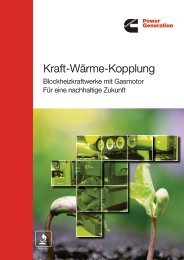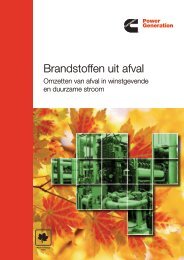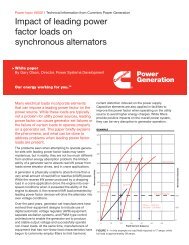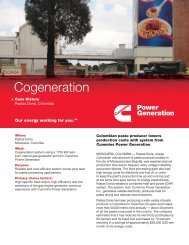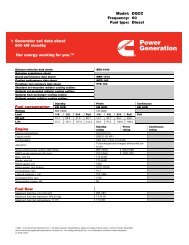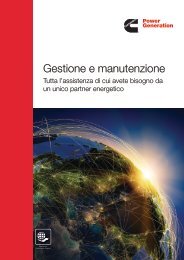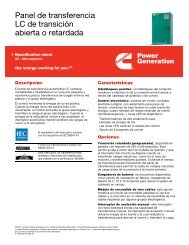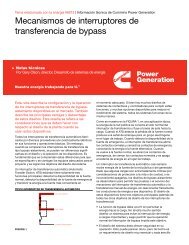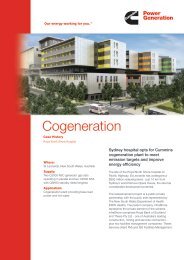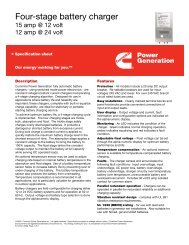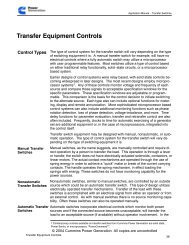appendix
appendix
appendix
You also want an ePaper? Increase the reach of your titles
YUMPU automatically turns print PDFs into web optimized ePapers that Google loves.
APPENDIX H<br />
Rev. Jan 2011<br />
Application Manual -- Liquid Cooled Generator Sets<br />
Figure 5--14. Typical One-Line Diagrams of Alternative System Grounding<br />
Methods .................................................... 5--33<br />
Figure 5--15. Typical Low-Resistance Grounding System for a Medium Voltage<br />
Generator Set and Load Transfer Equipment .................... 5--35<br />
Figure 5--16. Typical System and Equipment Grounding Connections at the<br />
Utility Service Equipment ..................................... 5--36<br />
Figure 5--17. Fault Effect on a 100 Ampere Breaker with Trip<br />
Characteristic “A” ............................................ 5--40<br />
Figure 5--18. Fault Effect on a 100 Ampere Breaker with Trip<br />
Characteristic “B” ............................................ 5--41<br />
Figure 5--19. PowerCommand) Control AmpSentryE Time-Over-Current<br />
Characteristic Curve Plus Alternator Damage Curve. ............. 5--44<br />
Figure 5--20. Typical Protective Scheme .................................... 5--45<br />
Figure 6--1. Anti--Vibration Provisions for a Typical Generator Set ............. 6--4<br />
Figure 6--2 Typical Vibration Isolating Foundation .......................... 6--6<br />
Figure 6--3. Typical Steel Spring Vibration Isolator .......................... 6--8<br />
Figure 6--4. A Generator Set Mounted With Spring--Type Vibration<br />
Isolators .................................................... 6--9<br />
Figure 6--5: Typical Features of an Exhaust System for a Generator Installed<br />
Inside a Building. ............................................ 6--11<br />
Figure 6--6. Typical Exhaust System ...................................... 6--12<br />
Figure 6--7. Generator Set Exhaust System Features. Dual Side Inlet Silencer,<br />
Flex Connectors, Exhaust Thimbles, and Mounting Hangers<br />
are Shown. ................................................. 6--14<br />
Figure 6--8. Typical Thimble Construction for Combustible Wall<br />
Installations. ................................................ 6--14<br />
Figure 6--9. A Simple Exhaust System Fitted With a Rain Cap to Prevent Rain<br />
From Entering the Exhaust. ................................... 6--16<br />
Figure 6--10. A Fabricated Rain Shield for Vertical Genset Exhaust Stack.<br />
Dimensions Shown are for a Typical 14--Inch Exhaust. ............ 6--16<br />
Figure 6--11. Sample Exhaust System for Calculation. ........................ 6--18<br />
Figure 6--12. Typical Muffler Exhaust Back Pressure vs. Gas Velocity ........... 6--20<br />
Figure 6--13. Exhaust Back Pressure in Nominal Inch (mm) Pipe<br />
Diameters .................................................. 6--21<br />
Figure 6--14. Typical Generator Set Heat Balance ............................ 6--25<br />
Figure 6--15. Typical Installation Of An Air--to--air Aftercooling System (jacket<br />
water system omitted for clarity) ............................... 6--26<br />
Figure 6--16. 2P2L Coolant Flow With Lta Thermostat Closed ................. 6--27<br />
Figure 6--17. Factory--supplied, Set--mounted Radiator Cooling ................ 6--28<br />
Figure 6--18. Set--mounted heat exchanger cooling. .......................... 6--29<br />
Figure 6--19. DFXX Generator Set Specification Sheet Showing ’Maximum<br />
Coolant Static Head’. ......................................... 6--31<br />
Figure 6--20. DFXX Generator Set Specification Sheet Showing ’Maximum<br />
Coolant Friction Head’. ....................................... 6--31<br />
Figure 6--21. Example remote radiator system. .............................. 6--32<br />
Figure 6--22. DFXX Generator Set Specification Sheet showing ’Coolant<br />
Flow Rate’ .................................................. 6--34<br />
Figure 6--23. Frictional Pressure Losses For Inch (Mm) Diameter Pipes ......... 6--35<br />
Figure 6--24. Typical Remote Radiator System .............................. 6--37<br />
Figure 6--25. Horizontal remote radiator example. ............................ 6--37<br />
Figure 6--26. Dual Heat Exchanger System (with secondary remote<br />
radiator) .................................................... 6--38<br />
Figure 6--27. Typical Integral Deaerating Tank Configuration ................... 6--40<br />
Figure 6--28. Typical Integral Deaerating Tank Configuration (radiator<br />
core omitted) ................................................ 6--40<br />
Figure 6--29. Remote Radiator System With Non--integral Deaerating Tank ......<br />
6--41<br />
H--3



